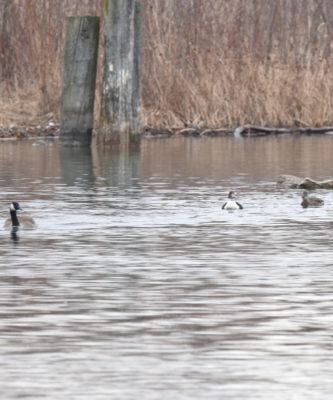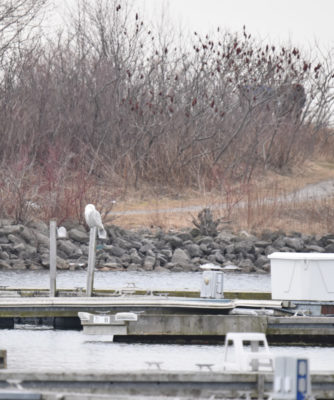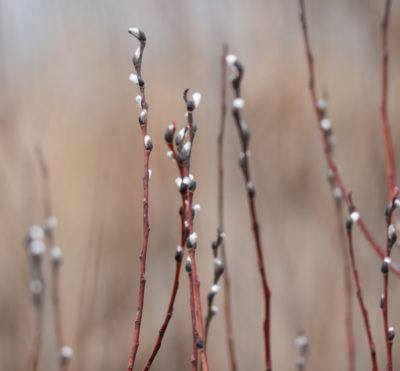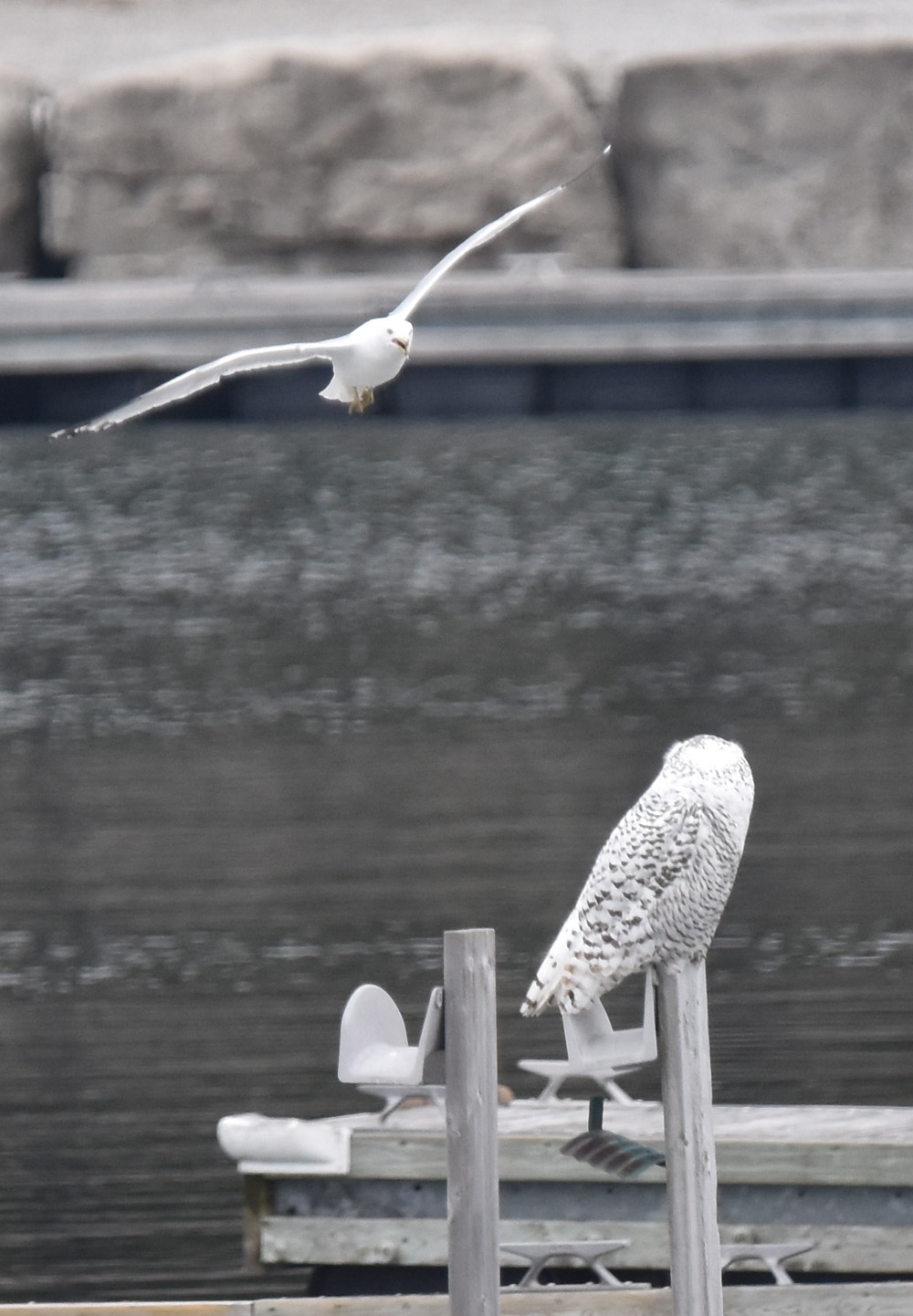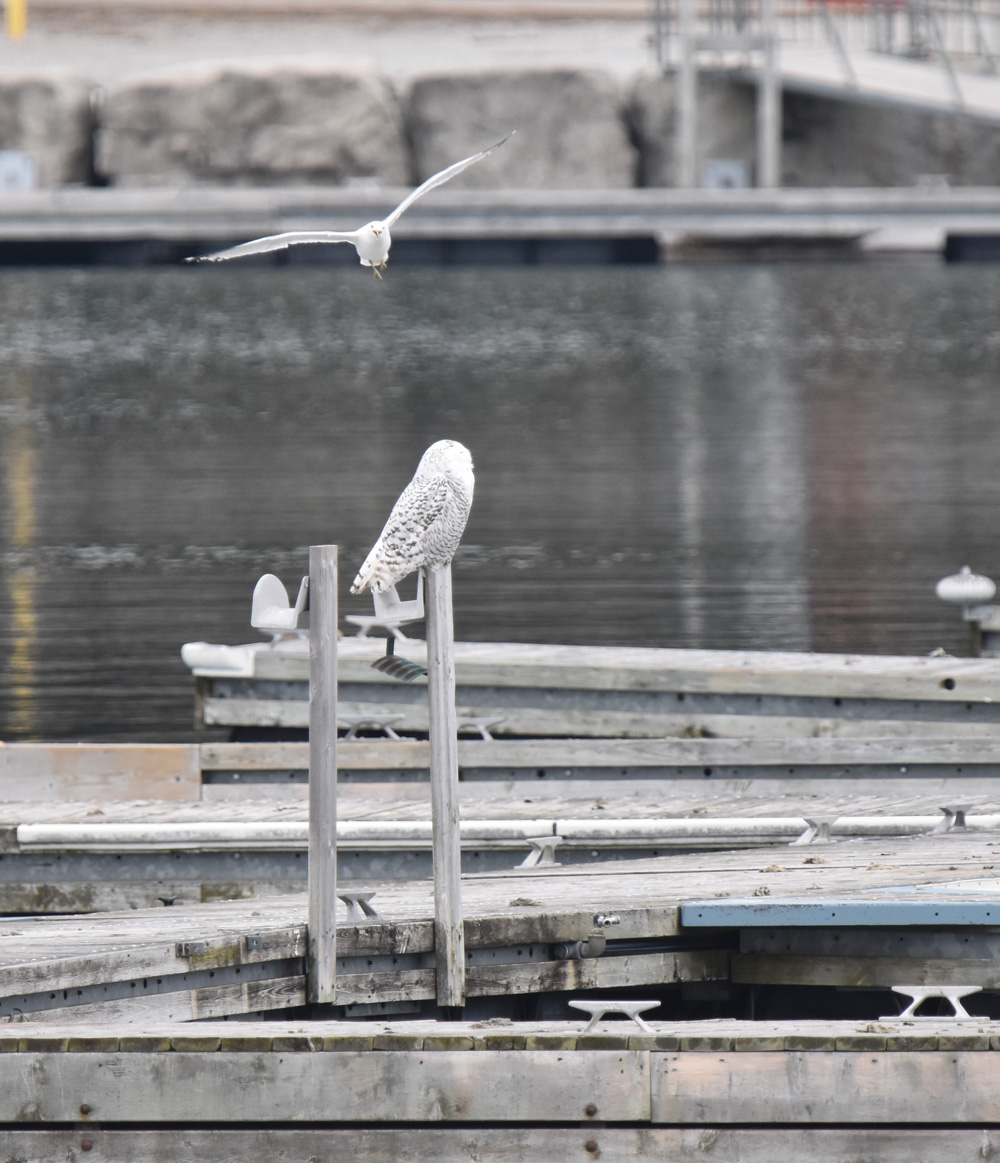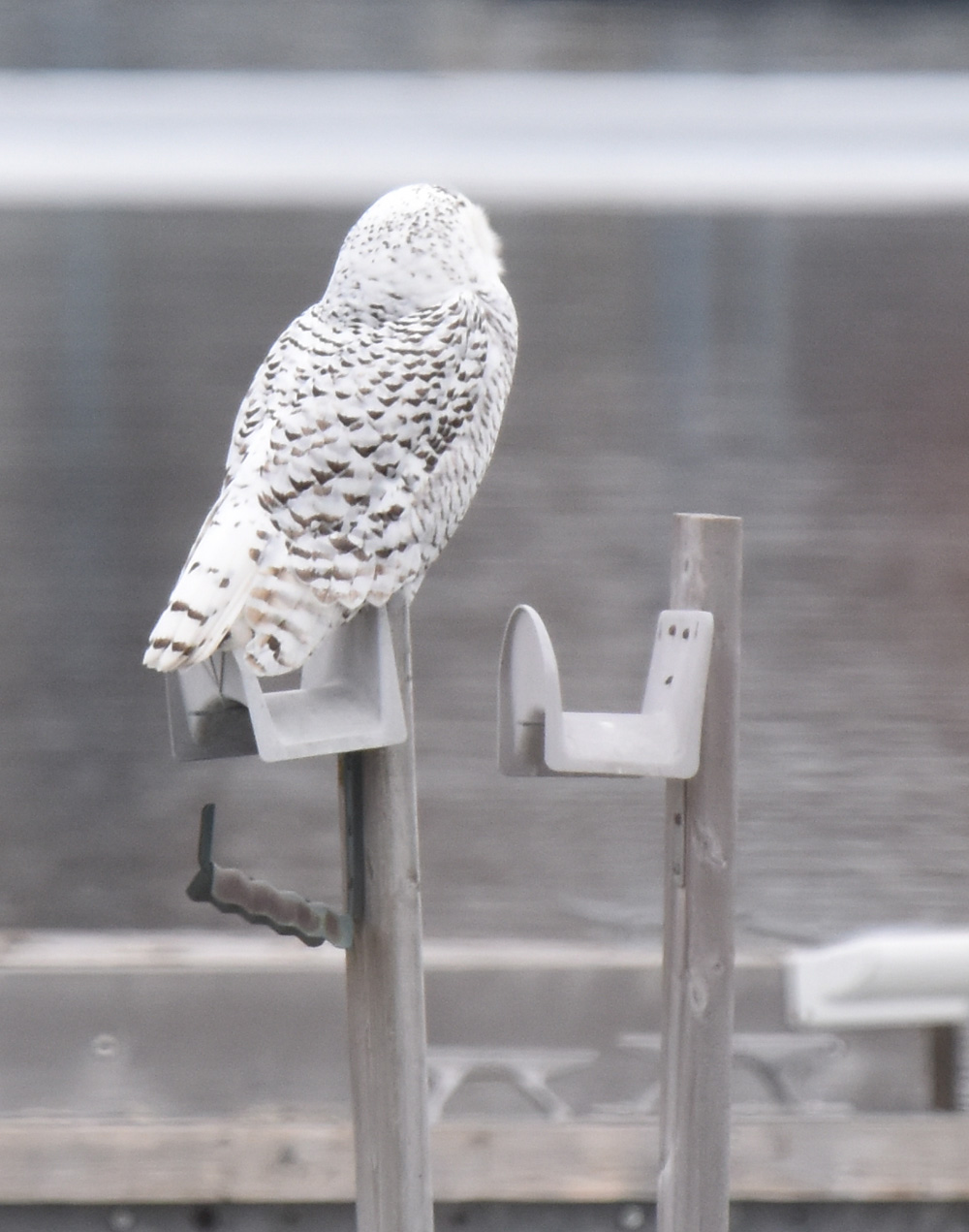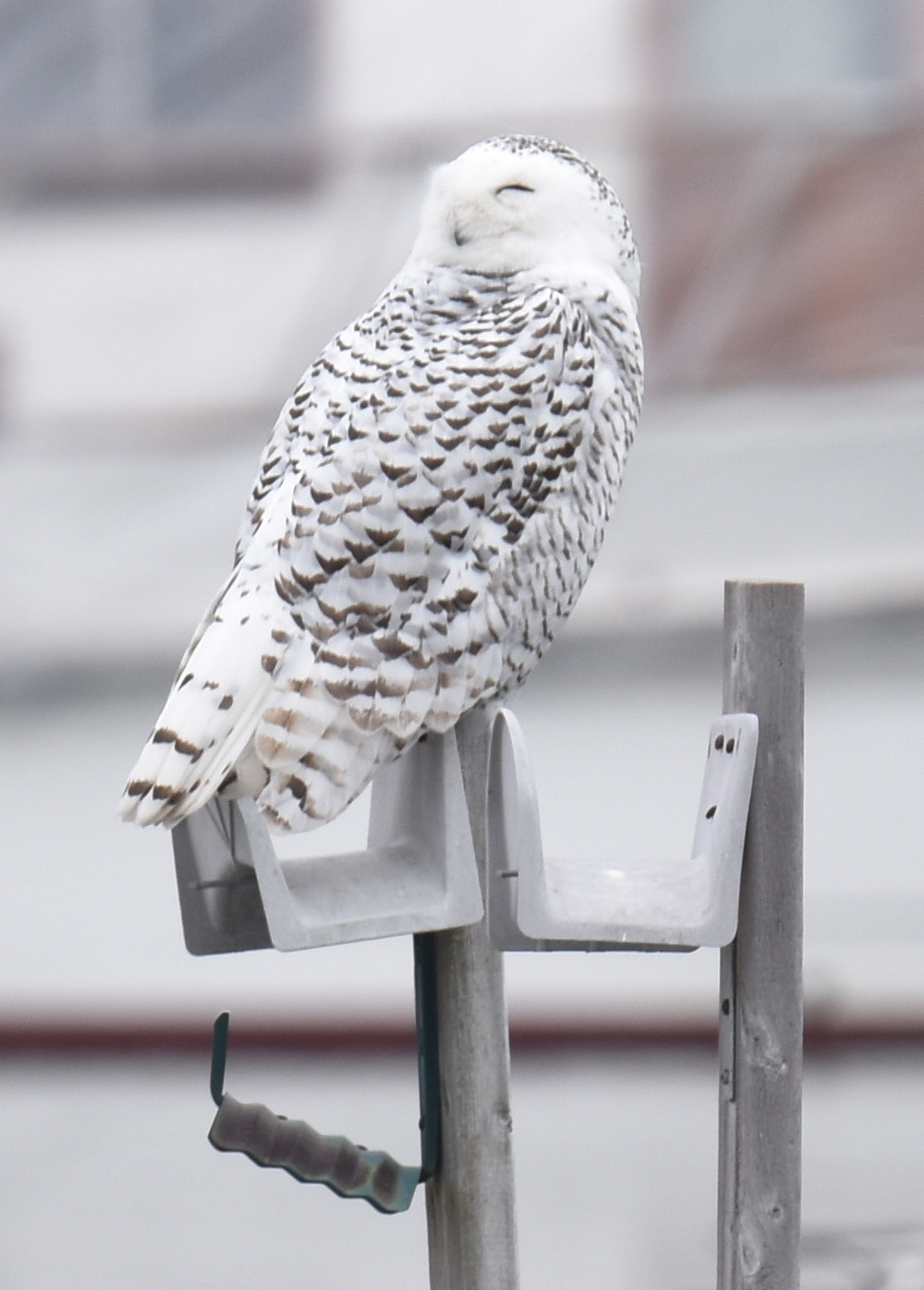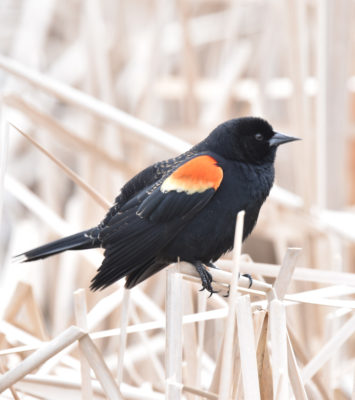No snow was falling on the last day of winter this year, so I decided to visit Colonel Sam Smith Park in Etobicoke for a ramble around the lake shore. For several months, a first winter King Eider had been living in the marina bay there and he sounded like a likely prospect for a photo and a close-up look. The trip took an unexpected turn for the better when I also found a Snowy Owl was perched at the end of the piers.
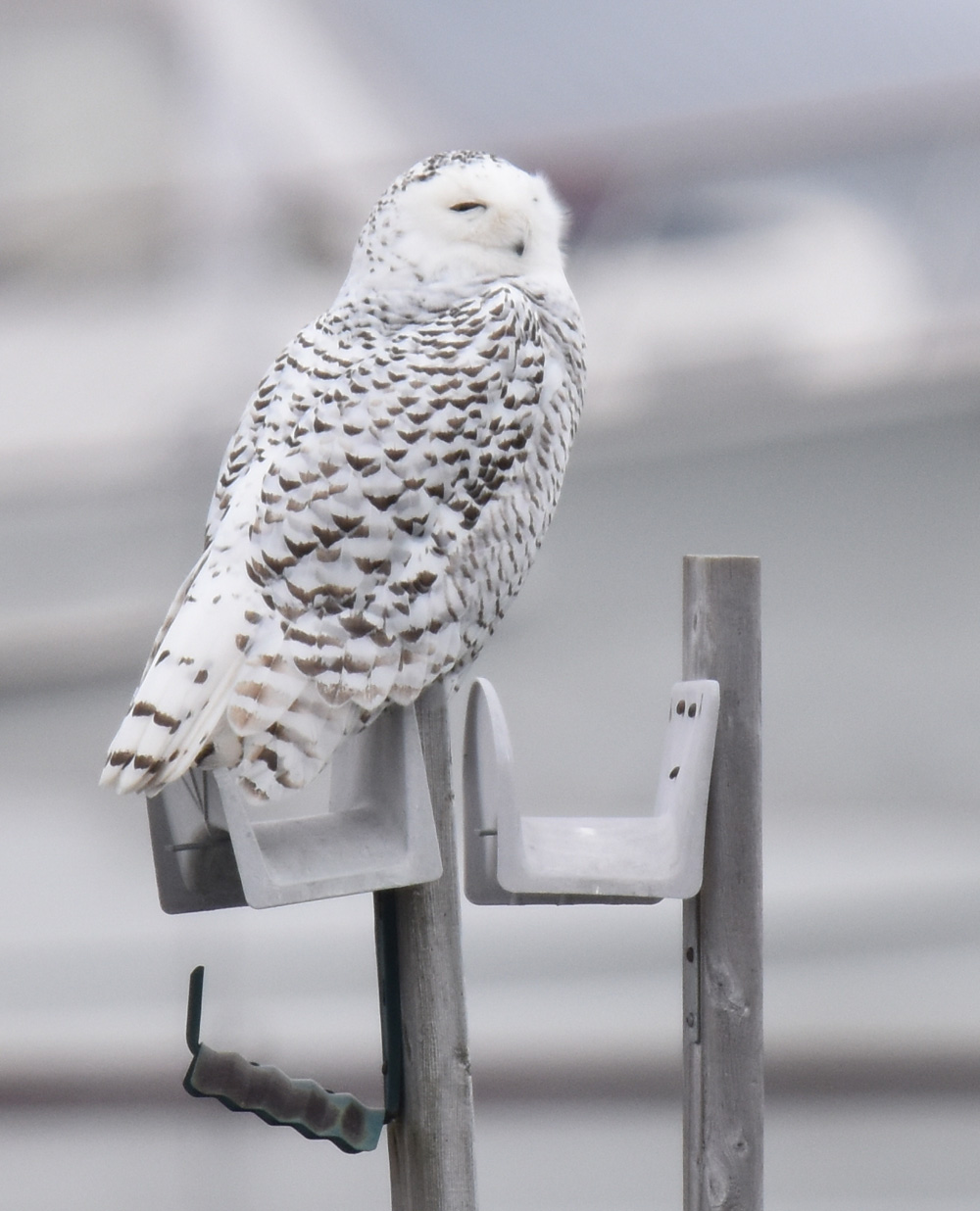
Sittin’ on the Dock on the Bay
First Birds of Spring and Last Birds of Winter Join in the Chorus
A scattered group of male Red-Winged Blackbirds chirk-a-ree’d from shrub tops all through the park when I arrived in the late morning at Colonel Sam. The ice of the skating loop was still frozen but looked soft and mud was the theme of the day on the trails. American Tree Sparrows and Juncos flew from brush to grass and back, adding a few cheerful chirps.
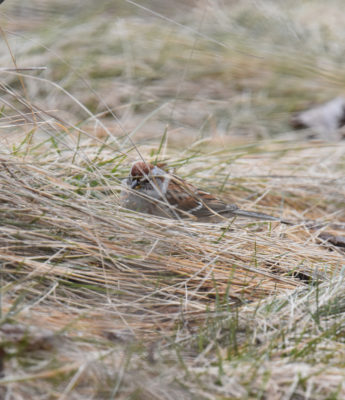
Why do I always see “Tree” sparrows on the ground?
I walked straight to the Marina lagoon rather than exploring the duck pond or trails. When I reached the water, I could see a small flock of Ring-billed gulls large pan of ice near the docks. A pair of Red-Necked Grebes called in their strange semi-hysterical way. And a bit closer to the eastern end, a group of Mallards was peeping and quacking.
What Compact Duck Has a White Bib and an Orange Lump on Its Bill?
Among the Mallards, I saw a dark duck with a white bib-like front. I thought, at first, that it was a domestic duck of some kind as it’s not unusual to have domestic ducks join the flocks along Lake Ontario. I snapped a quick photo and then turned to speak with a lovely woman and her daughter who had brought a bucket of grain and had just finished feeding the birds.
She told me that there was a Snowy Owl on the docks, and when I looked out over the water, I could see it perched on the end of the wharves furthest from shore. There were also two photographers on the peninsula of land opposite. The bird was perched and sleepy looking. I doubted it would still be there even if I raced over so I took a few record photos happily and turned back to the Mallards.
The raft of ducks had swum very close to me now, hoping for more handouts. And I could see my bib-fronted duck was no domestic Mallard. It was the hoped-for first winter male King Eider. Now that he was literally only a few feet from me, I could clearly see where his bill was thickening with the start of the bright orange lump that he would grow as an adult male. An immature male, he didn’t have the pale blue head, or the crisp white and black back.
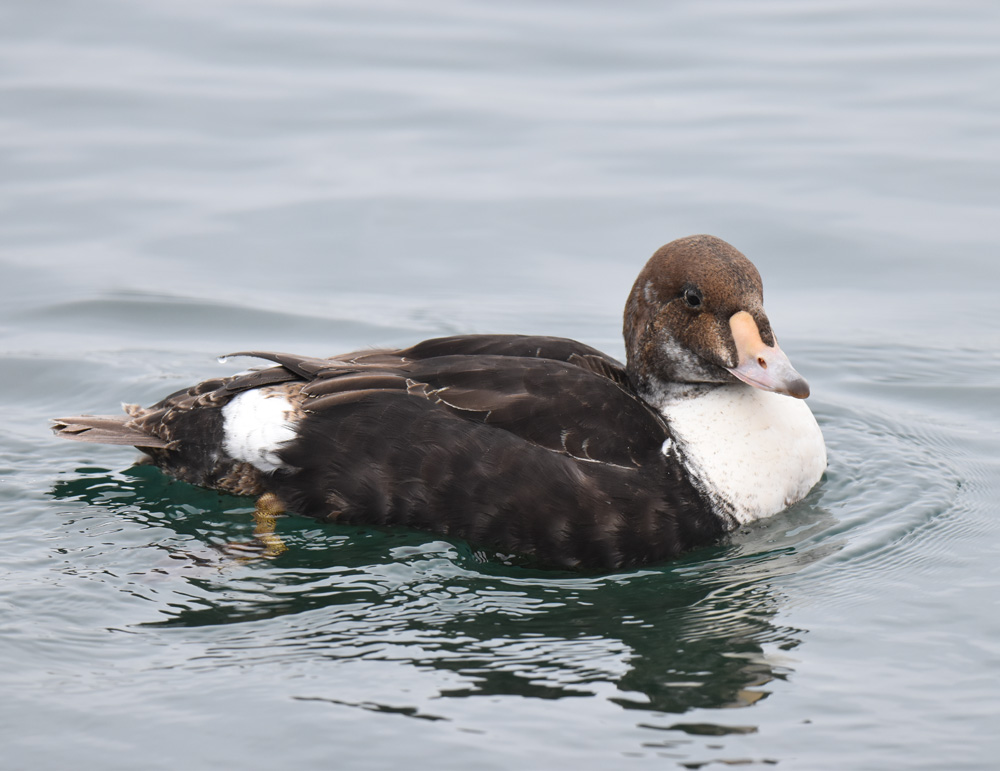 A First Winter male King Eider duck.
A First Winter male King Eider duck.
The King Eider was more compact than I expected. Smaller than some of the Mallards, he was chunky and short. His build reminded me a bit of a toy duck.
What Do King Eiders Eat?
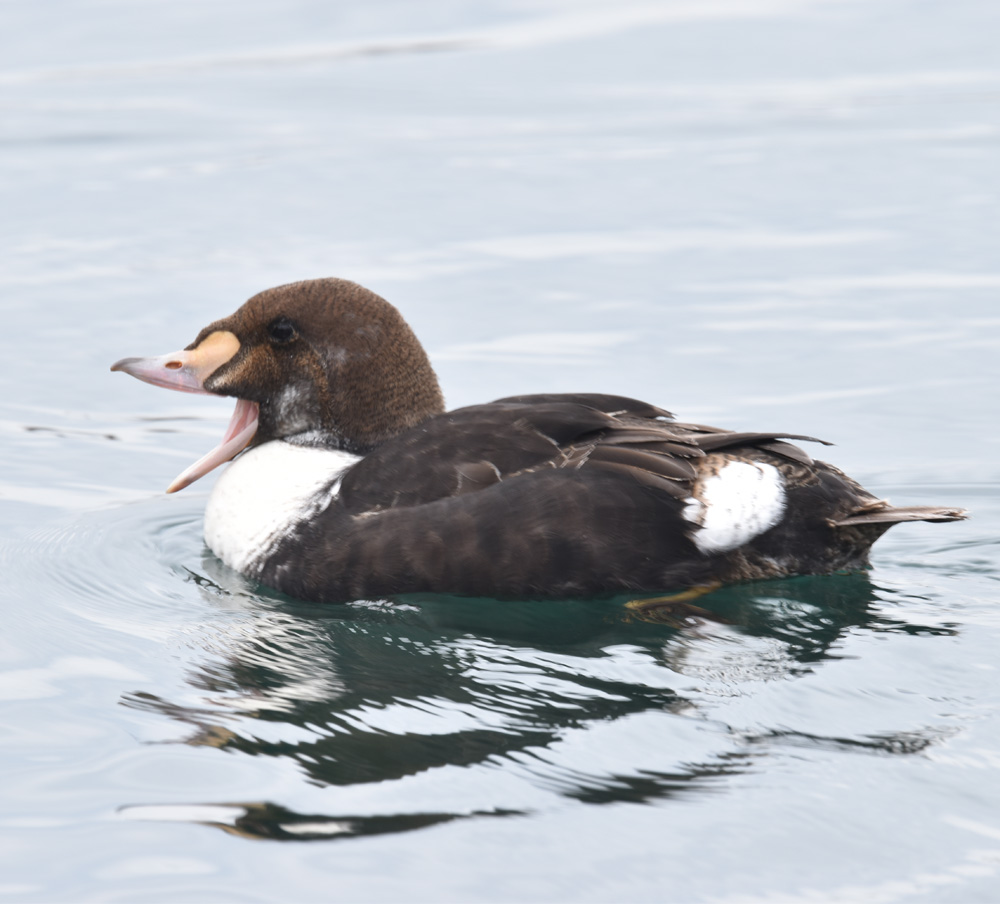
I found the King Eider’s call quite amusing: it was almost a series of Coos.
It was obvious that this particular young King Eider was quite willing to eat any bread or grain thrown to the flock of Mallards. I wondered, though, what wild King Eiders eat.
They normally breed in the Arctic in the summer, and spent their winters along the ocean coasts. This one was so far from its normal homes, I didn’t think I could trust its eating habits to be normal.
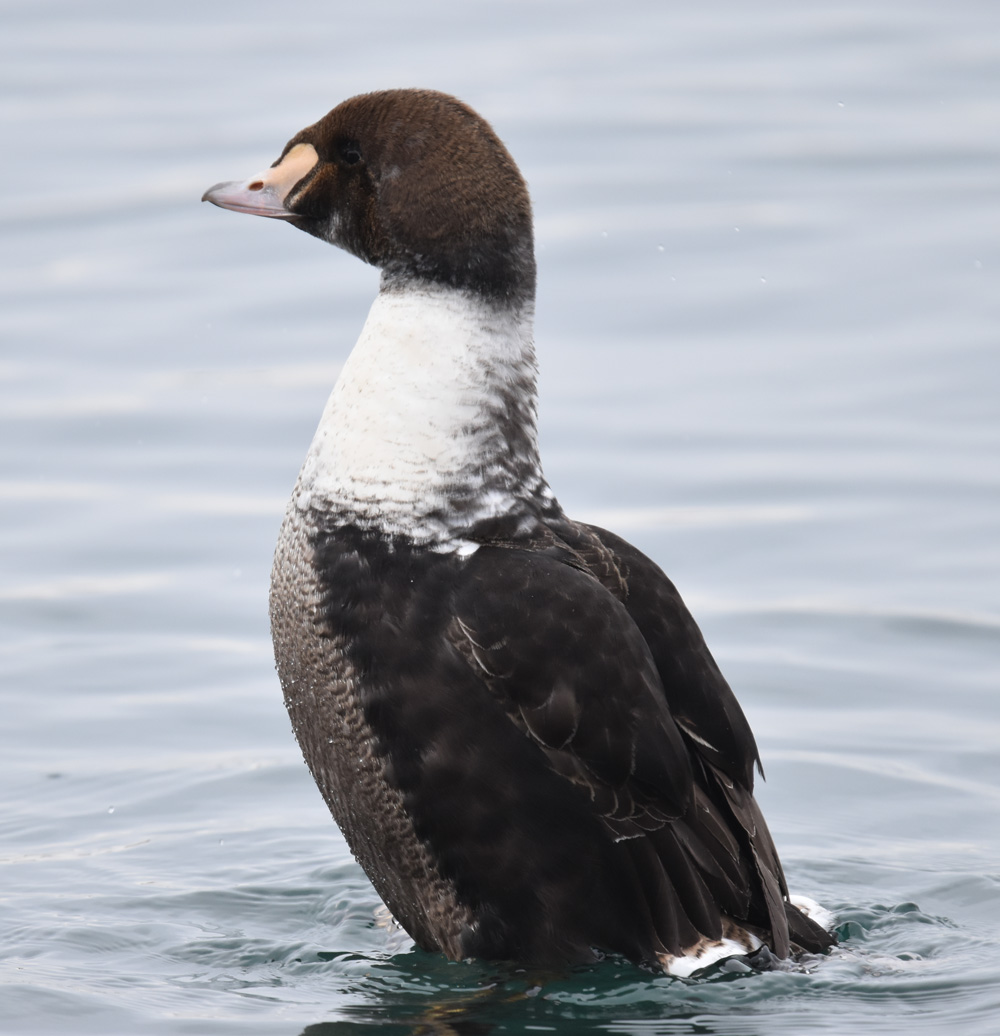
I like the “tweedy” feathers on his front below the bib.
The AllAboutBirds website says that King Eiders normally eat by foraging at the bottom of wet habitats for plants, insect larvae and crustaceans. In the winter on the seas, they add mollusks and echinoderms to their menu. I double-checked and as I thought, echinoderms include sea stars and sea urchins. I wonder if they eat the Purple Seastars that we saw so many of in the tidal pools in PEI?
After enjoying such quick and easy close-up looks at the King Eider, I decided to ramble out along the peninsula and hope the Snowy Owl would let me take a few closer photos too.
More Signs of Spring En Route to a Snowy Owl
The Pussywillow buds are swelling and softly fuzzy already. A Song Sparrow was back (or never left) and was bravely singing despite a rather cold breeze off the Lake. Once more, the Red-necked Grebes that will likely stay and nest in the Marina lagoon were rearing up and calling. And the mud was thick and glutinous underfoot making me very glad I had worn boots.
Ring-billed Gulls Try to Drive Off a Somnolent Snowy Owl
Part-way along the shore, I heard several Ring-billed Gulls start shrieking. Looking forward, I saw they had decided to try to drive the Snowy Owl from its roost.
The gulls were whirling and diving towards the owl. They made long, high loops, though and never came very close. Obviously they were wary of retaliation. The owl, for its part, ignored them.
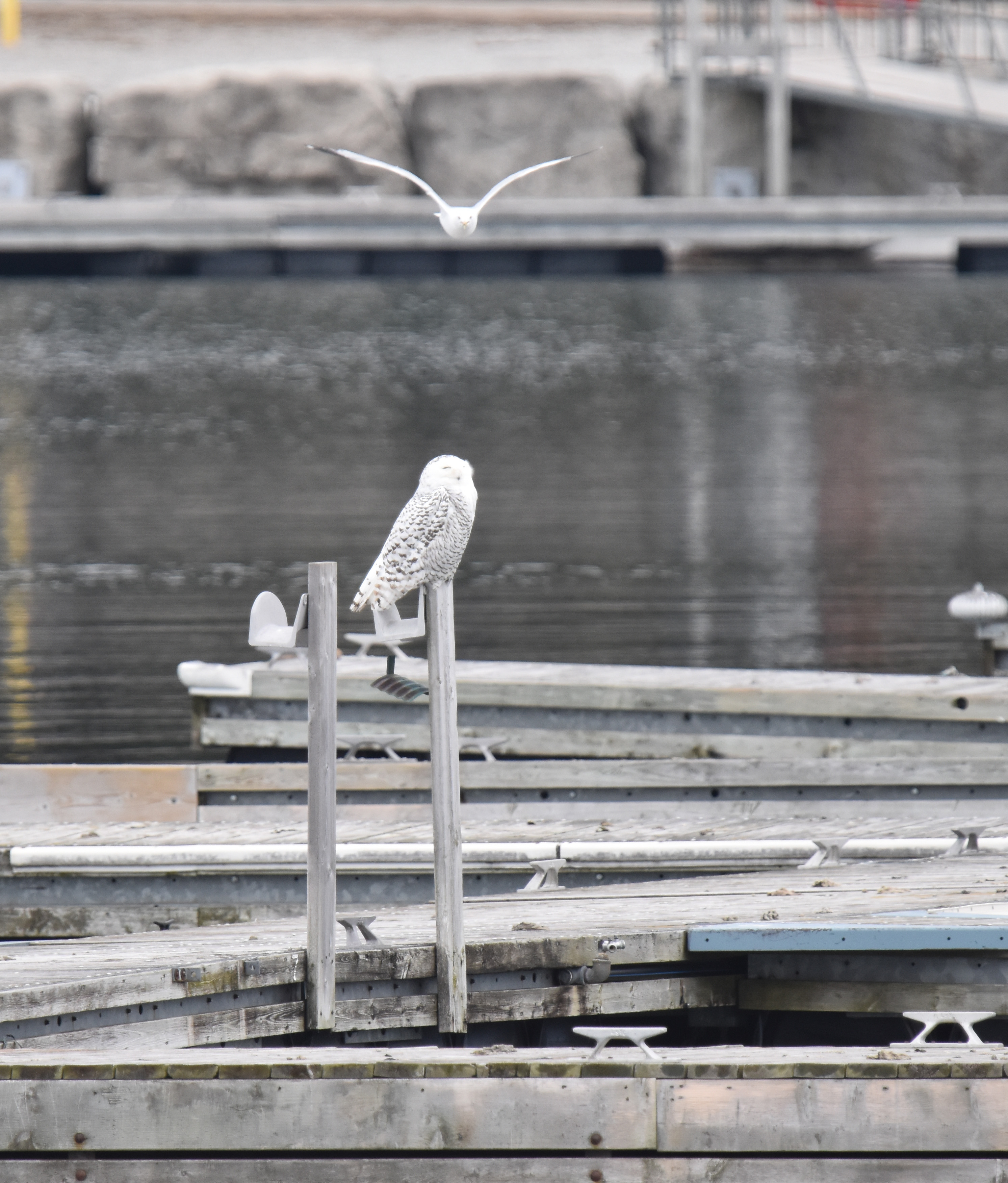
The Snowy doesn’t even bother to watch the gull half of the time.
I stayed still, watching, wondering if the Owl would give up and fly to get away from the noise, and if so, whether it would fly towards or away from me.
After a few minutes, however, when the Owl refused to budge, the gulls gave up and settled back down on the ice.
Snowy Owl Supremely Indifferent to the Passage of People
The Snowy Owl did wait till I came alongside the dock-facing shore. Although it was closer than when seen from the far side of the lagoon, it was still a good distance away. It was also feeling fairly relaxed and had its eyes closed most of the time. When it did turn to look around it rarely fully opened its eyes and it didn’t seem even remotely interested in the whirr and click of camera shutters so far away across the water.
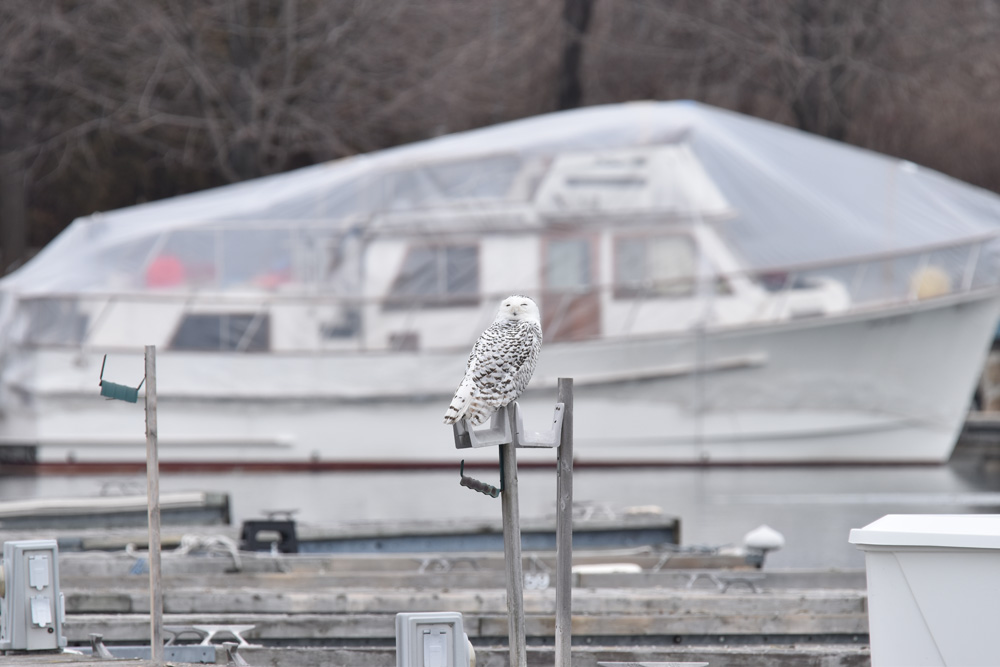
I suppose the tarp is to keep ice and dirt off of the boat–but wouldn’t it be kind of neat to brag you had Snowy Owl poop on the poop-deck?
I could barely tell, frankly, when it was facing me and when it was looking away. Some slight differences in the facial colouring from the bill and eyes, though, were just enough incentive for me to snap off a few more photos.
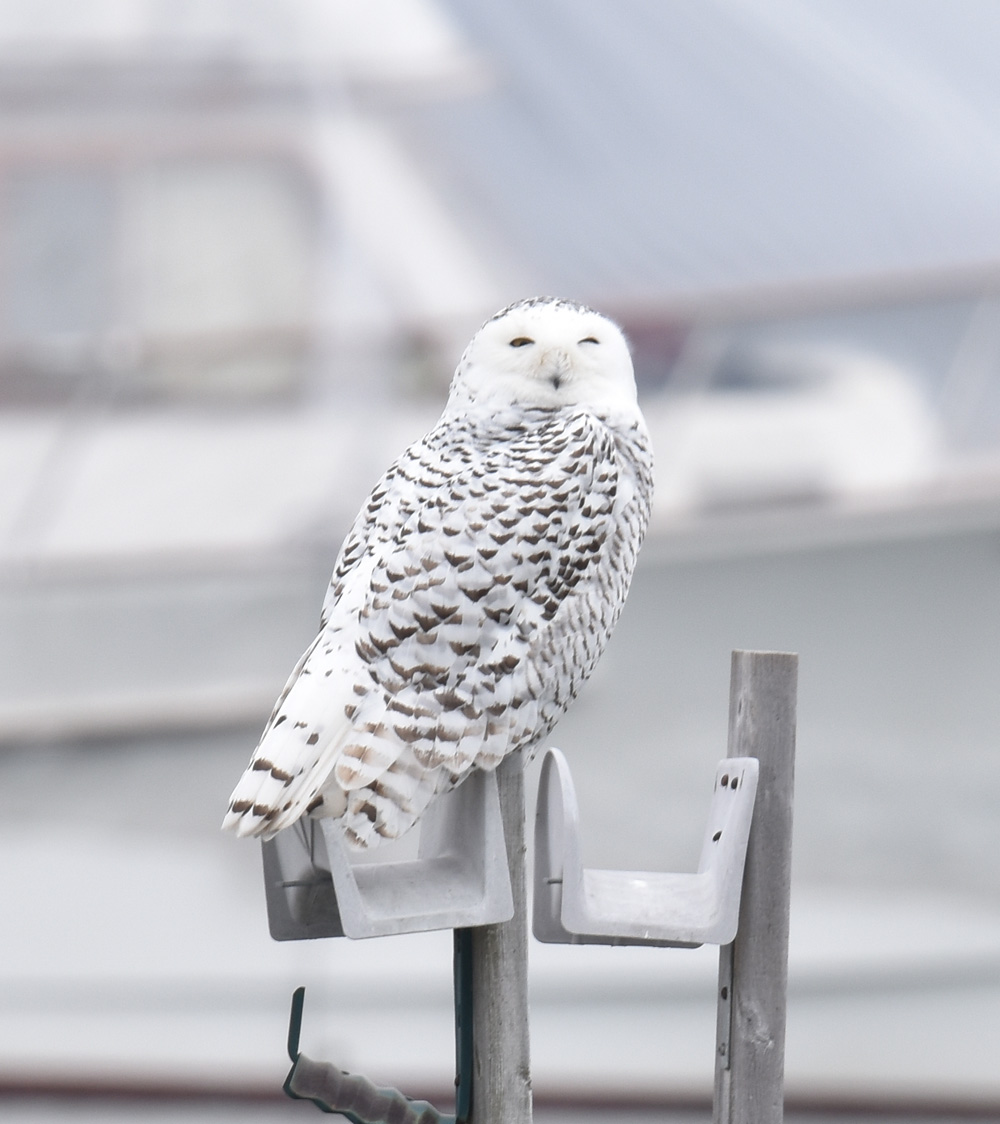 This is the widest it opened its eyes while I was watching.
This is the widest it opened its eyes while I was watching.
It seemed very fitting to see a Snowy on the last day of winter so after taking the requisite photos I paced on through the mud out to the tip of the point.
Along the outer breakwater rocks, I found the gruesome remains of a predator’s morning meal. A wing and a head of a Ring-billed gull lay on top of a limestone block. It may have been the Snowy Owl’s discards–if so, it could explain why the other gulls tried to drive it away! But at this time of year, other predatory birds including peregrine falcons move through the area, so I don’t know for sure who ate the gull. (I won’t include any photos in case you’re eating your own breakfast!)
Winter Ducks Drift Idly on the Lake
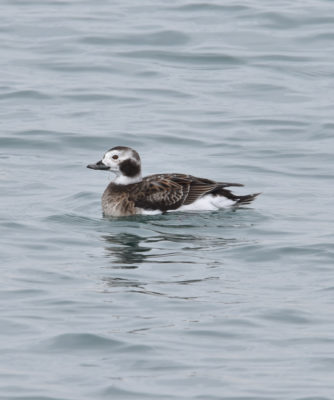
A Long-tailed Duck waiting for the spring thaw.
I did see some of the winter ducks that will soon be gone as well. Long-tailed ducks were sleeping and diving on the outer side of the peninsula. Red-breasted mergansers were fishing. A bobbing pair of Bufflehead was dwarfed amongst a group of 6 Mute Swans. Some Goldeneye were resting.
And, as usual, many pairs of Gadwall pushed out to sea from near the rocks as I walked along the breakwater boulders. I don’t know why Gadwall are always so wary of walkers considering the Mallards actually come close in begging for handouts. These ducks seem to stay year round so it seems unlikely they been subject to near misses by hunters. Yet almost all my photos of Gadwall are of them steadily paddling away out from the shore.
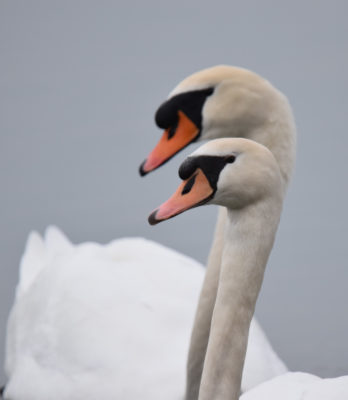
The Mute Swans have started displaying and strengthening their pair bonds again.
I circled back to the start of my walk by way of the Duck Pond. As one could expect, it had a dozen Mallards clustered in the only end with open water. Most of the pond was frozen due to a recent cold snap. A pair of Mute Swans was also hoping for handouts, possibly the same pair who nested in the rushes beside the observation platform last spring.
The chorus of Red-winged Blackbirds was still singing as I left the park, quite happy with this pleasant few hours’ adventure.
Related Reading
- Another Duck with an Odd Orange Bill, the Surf Scoter
- A Snowy Owl Near Stelco
- What Black and White Duck Has a Green Head and a Blue Bill and Winters in Lake Ontario Near Toronto?
- What Almost Black Large Diving Duck has a White Eye Comma and a White Wing Patch?
Join In
Did you see one of the King or Common Eiders that visited the Greater Toronto Area this winter? Or do you regularly see Eiders along their coastal wintering grounds? Please share your sighting with a comment.

